


xxxxxAs we have seen (1863), it was the French painter Édouard Manet who became the nominal head of the Impressionists, a group of young artists which included Claude Monet, Pierre-Auguste Renoir, Alfred Sisley, Camille Pissarro, Paul Cézanne and Edgar Degas. Taking their lead from Monet, they broke away from the restrictions imposed by the artistic hierarchy in Paris and, each in his own way, adopted the basic aims of the new art form. They painted out of doors and attempted by rapid, broken brush strokes and strong colours to capture at a precise moment the colour, light and movement of an ordinary, everyday scene. Monet, who gave the movement its name by his work of 1872 entitled Impression, Sunrise, began painting scenes in the forest of Fontainebleau or on the north coast at Honfleur and Le Havre in the 1860s, accompanied by various members of the group. His works of this period included Bathers at La Grenouillère and The Beach at Trouville. During the Franco-Prussian War of 1870/71 he took refuge in London, where he painted a number of realist views, including his famous The Thames below Westminster. On his return, he lived at Argenteuil for a time, and it was there, working alongside his colleagues, that he produced some of his finest works, such as The Seine Basin near Argenteuil, Poppies Blooming, and St. Lazare Station. He spent the last 40 years of his life at his home at Giverny, 50 miles west of Paris, and it was here that he embarked on a “series” of paintings to depict a particular subject in various conditions of light and season, such as Haystacks, the façade of Rouen Cathedral, Poplars, and the Water Lilies in his own garden. Impressionism, of which he was the greatest exponent, was slow in being accepted by the general public, and by the early 1880s the majority of its founder members had moved away from its restrictive style and subject matter. However, as we shall see, Pointillism, pioneered by the French artists Georges Seurat and Paul Signac (1884 Vc) owed much to the movement, and painters such as Van Gogh and Paul Gauguin retained the brilliant colours associated with Impressionism.
IMPRESSIONISM and CLAUDE MONET
1840 - 1926 (Va, Vb, Vc, E7, G5)
Acknowledgements
Monet: Impression, Sunrise – Musée Marmottan, Paris; The Beach at Trouville – National Gallery, London; Poppies Blooming – Musée d’Orsay, Paris; The Gare Saint Lazare, Paris – National Gallery, London; The Thames below Westminster Bridge – National Gallery, London; Studio Boat – Rijksmuseum, Kroller-Muller Museum, Otterlo, Netherlands; Pleasure boats at Argenteuil – Musée de l’Orangerie, Paris; Bridge over a Pond of Lilies – Metropolitan Museum of Art, New York; Poplars on the bank of the Epte – National Galleries of Scotland, Edinburgh; San Giorgio Maggiore at dusk – National Museum of Wales, Cardiff. Sargent: Madame X – Metropolitan Museum of Art, New York; Claude Monet painting by the edge of a wood – Tate Gallery, London; Bedouins – Brooklyn Museum, New York; Artist in the Simplon – Fogg Museum, University of Harvard, Cambridgep, Massachusetts; Gassed – Imperial War Museum, London; Carnation, Lily, Lily Rose – Tate Gallery, London; The Village Children – Yale University Art Gallery, New Haven, CT, USA.
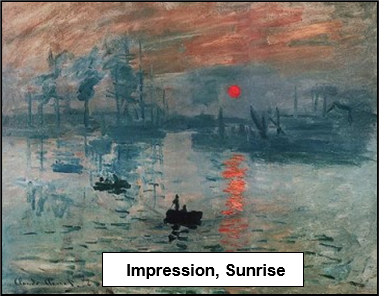
xxxxxAs we have seen (1863), it was the French painter Édouard Manet who did much to advance the movement known as Impressionism, though not intentionally so. It was his two avant-garde paintings Picnic on the Grass in 1863 and Olympia two years later that made him an arch rebel and put him at the head of a group of non-conformist artists. His studio and the Café Guerbois in the Batignolles Quarter of Paris became meeting places for a band of young hopefuls who wished to break free from the narrow rules of style and subject matter imposed by the Academy des Beaux-Arts in Paris.
xxxxxAmong these dissidents was a group of painters who were determined to introduce a new kind of realism on canvas. Among its number were, Claude Monet, Pierre-Auguste Renoir, Alfred Sisley, Camille Pissarro, Paul Cézanne and Edgar Degas. All in their own ways (and including Manet) were to adopt in full or in part the ideals implicit in what came to be known as “Impressionism”, but it was the first artist mentioned, Claude Monet, who was to be the leading pioneer in this new art form. And it was he who, inadvertently, was to give the new movement its name. Under his experimental work and guidance the movement took on its distinctive style.
xxxxxMonet was obsessed with the idea of painting outdoors (en plein air) in order to capture at a precise moment the colour, light and movement of an ordinary, everyday scene. This momentary glimpse - devoid, by its very nature, of firm outlines - was to be achieved by the use of pure colour applied in short, juxtaposed fragments in order to create, by their vivid intensity, the overall atmosphere of the scene, caught, for example, by the flickering changes in light, the ripple of the water, or the subtle movements caused by a breeze. The artist provided colour in the required format, and the human eye compiled the picture. And in this open composition, dark shadows in black or browns were replaced by softer tones of mauve or blue as an additional means of blurring the outlines. These were the hallmarks of Impressionism, and they were adopted, as we shall see, by a diverse group of young artists who, in broad terms, followed his lead and produced a new and enduring type of painting.
xxxxxMonet was born in Paris but at the age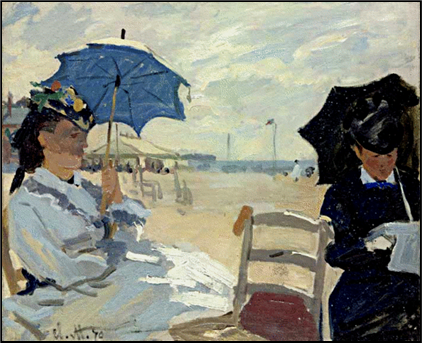 of four, the family moved to Le Havre, a busy port in Normandy. Here Monet showed early promise as an artist, and by the age of sixteen he was making quite a good living drawing charcoal caricatures of local people. However,xencouraged by a local marine artist named Eugène Boudin (1824-1898), he became convinced that only by painting out of doors could he capture - in Boudin’s words - “the power and vividness of the first impression”. In 1858 he became a student at the Atelier Suisse in Paris and then, following two years military service in Algeria, returned to study at the École des Beaux Arts. It was here that he met three men who enthusiastically shared his views on art - Renoir, Sisley and Frédéric Bazille. Over the next few summers, with them or without them, he painted in the forest of Fontainebleau or on the north coast at Honfleur and Le Havre, capturing the effects of light by rapid brushstrokes of broken colour. And it was at that time that he met Manet and inspired him - though not at once - to paint nature out of doors. To this period belongs Bathers at La Grenouillère, The Woman in the Garden (his future wife Camille), and in 1870, The Beach at Trouville (illustrated here). These were brilliant examples of his developing style, but they found little favour with the critics or the general public.
of four, the family moved to Le Havre, a busy port in Normandy. Here Monet showed early promise as an artist, and by the age of sixteen he was making quite a good living drawing charcoal caricatures of local people. However,xencouraged by a local marine artist named Eugène Boudin (1824-1898), he became convinced that only by painting out of doors could he capture - in Boudin’s words - “the power and vividness of the first impression”. In 1858 he became a student at the Atelier Suisse in Paris and then, following two years military service in Algeria, returned to study at the École des Beaux Arts. It was here that he met three men who enthusiastically shared his views on art - Renoir, Sisley and Frédéric Bazille. Over the next few summers, with them or without them, he painted in the forest of Fontainebleau or on the north coast at Honfleur and Le Havre, capturing the effects of light by rapid brushstrokes of broken colour. And it was at that time that he met Manet and inspired him - though not at once - to paint nature out of doors. To this period belongs Bathers at La Grenouillère, The Woman in the Garden (his future wife Camille), and in 1870, The Beach at Trouville (illustrated here). These were brilliant examples of his developing style, but they found little favour with the critics or the general public.
xxxxxWith the outbreak of the Franco-Prussian war in July 1870, Monet took refuge in London to avoid conscription. There he met up with his friend Pissarro, also in London to escape the war, and together they studied the works of the English painters Constable and Turner, artists who, like them, painted directly from nature. During his brief stay in the capital Monet painted realistic views of Hyde Park and the Thames. Famous amongst these was his The Thames below Westminster (illustrated below), a magnificent, almost monochrome view of the busy river, seen through an eerie morning mist. Then after a few months stay in the Netherlands - during which time, fascinated by the immensity of the sky and the abundance of water, he produced no less than 25 paintings! - he returned to France in the autumn of 1871. In the December he settled at Argenteuil, a village on the Seine just outside Paris.
xxxxxMonet lived at Argenteuil for the next six years and during this time he painted some of his finest works, accompanied at varying times by Sisley, Renoir, Manet, Pissarro, Degas and Cézanne. In 1873, to coordinate their efforts, they formed the so-called Anonymous Cooperative Society of Artists, but their works were openly ridiculed as crude and unfinished. As a result, their exhibition, held in Paris the following year (the first of eight) was a complete failure, but it was on this occasion that Monet’s work entitled Impression, Sunrise (illustrated above), painted on a visit to Le Havre in 1872, gave the movement its familiar name: Impressionism. It was meant as a term of derision (made by the art critic Louis Leroy), but in fact it was readily accepted by the “Impressionists”, being seen as an apt description of the spontaneity they sought to achieve. But despite this lack of public approval, Monet’s stay at Argenteuil was one of his most productive periods. Among his works during these years - all fine examples of his individual style - were The Seine Basin near Argenteuil, The Artist’s House at Argenteuil, Poppies Blooming and the Gare Saint Lazare in Paris, a brilliant painting - one of seven on this subject - full of bellowing smoke and movement. (The last two illustrated below.)
Including:
John Singer Sargent

Vb-1862-1880-Vb-1862-1880-Vb-1862-1880-Vb-1862-1880-Vb-1862-1880-Vb-1862-1880-Vb
xxxxxCamille Monet died in September 1879 after a long illness. For a time Monet shared a house with the Hoschede family at Vetheuil and then Poissy, but in May 1883 they rented a house at Giverny, 50 miles west of Paris. Seven years later, with his paintings selling well, he was able to buy the house and its extensive gardens. During this unsettled period Monet embarked on a “series” of paintings in which he took a particular subject and depicted it in various conditions of light and season. This novel idea - in keeping with his obsession to capture a scene of the moment - occupied him for the rest of his life. These “series” included a study of snow scenes at Vétheuil, Haystacks, the façade of Rouen Cathedral, Poplars, Mornings on the Seine and Water Lilies, a swirling mass of colour known collectively as the Nymphéas and painted in his own garden at Giverny. Abroad he made a series of paintings in London (including Parliament and Charing Cross Bridge) and, attracted by the lucidity of the light and its stunning effects upon water, he produced land and seascapes during a number of visits to the Mediterranean, the first in the company of Renoir. Among these was Old Fort at Antibes, a location he described as the most beautiful in the world. In 1908 he produced a series of works while staying in Venice, and at the end of the First World War he painted a series of Weeping Willows, part of his Nymphéas collection, in memory of those Frenchmen who had been killed during the conflict. Creations of his singular vision, some of these later works bordered on abstraction.
xxxxxMonet died of lung cancer in December 1926, aged 86, and after a simple service was buried in the cemetery at Giverny Church. His house and gardens, which he had greatly improved over the years, were made open to the public. Among items on show are his valuable collection of Japanese woodcut prints. Japanese art, its colours and composition, influenced his work and that of his fellow Impressionists.
xxxxxIn his early years Monet had a hard life. In 1866, following a quarrel with his parents, he lost his allowance and for the next twenty years or more he lived a hand-to-mouth existence. At one stage Bazille bought one of his paintings, paying him in monthly instalments to provide him with a regular income, and it is known that Renoir would often smuggle out bread from his parents’ home to feed his friend. However, his paintings began to sell well in the 1880s, and towards the end of his career the patronage of the French prime minister, George Clemenceau, guaranteed him a comfortable living. Nevertheless his works never realised their true potential during his lifetime. In 2008 one of his water lily series, Le bassin aux nymphéas, was sold in London for £3,500,000!
xxxxxIllustrated below are three paintings from the 1870s and three later works. Attracted always by water, be it the sea at Le Havre or the Seine in Paris, he used the little boat (centre) as a floating studio to capture the changing effects of shadow and reflection along the riverbank.
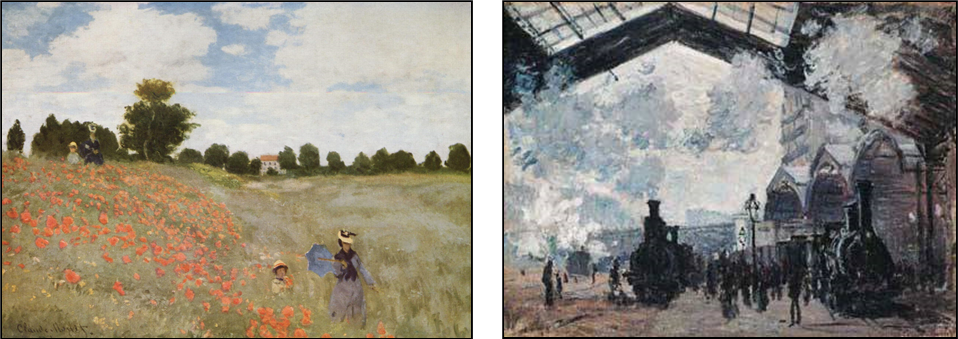
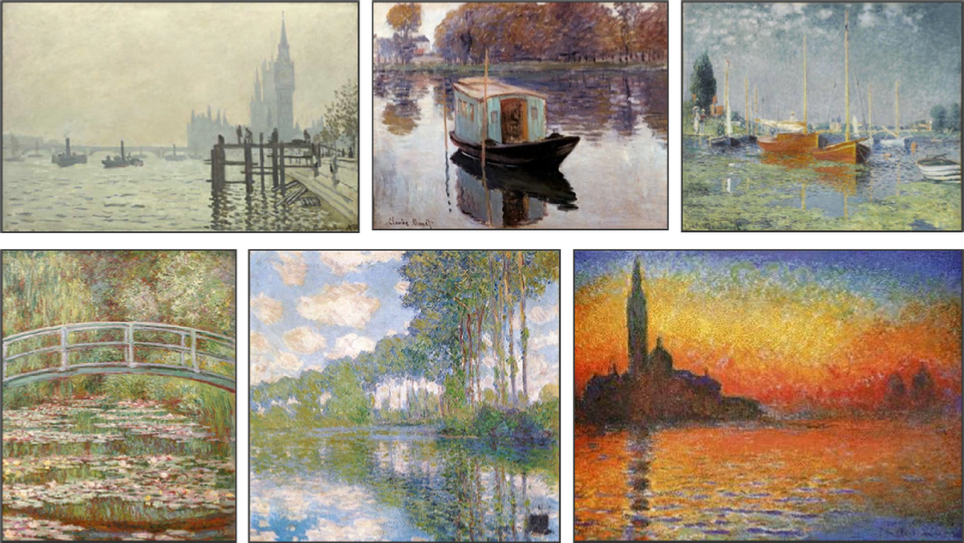
Left to Right: (Above) The Thames below Westminster Bridge 1871; The Studio Boat 1874; Argenteuil 1875; (Below) The Bridge and Lilies 1899; Poplars on the Epte 1900; and View of Venice 1908.
xxxxxThe Impressionist Movement had first come into prominence at the Salon des Refusés in 1873, anticipated in some respects by the strong colours of Delacroix and the natural landscapes of artists like Courbet, Corot and members of the Barbizon School. After a great deal of scorn and disapproval, its unique style had won a certain degree of acceptance, but by the early 1880s it had lost its momentum. Its fresh, original vision had faded, and a number of its founder members, differing as they did in style and temperament, had started to exhibit their work at the Salon or had gone their own way. Indeed, Pissarro was the only artist who exhibited at all of the Impressionists’ own exhibitions, and even he was not persistent in style. Nor, as new artists dabbled in the movement, had the early quality been retained. In 1880 Monet complained bitterly about the poor technique of some of the “first-come daubers”.
xxxxxHowever, as we shall see, the new styles that emerged in the 1880s owed something to Impressionism. Pointillism, for example, a technical device pioneered by the French artists Georges Seurat and Paul Signac (1884 Vc), was a spin-off which came to be known as Neo-Impressionism, and a number of painters, such as Van Gogh and Paul Gauguin (grouped together under the vague title of Post Impressionism), although adopting a very different style, nonetheless retained the brilliant use of colour associated with the pioneers of Impressionism.
xxxxxIncidentally, the French artist Frédéric Bazille (1841-1870), was a close friend of Monet, Sisley, Renoir and Manet, and painted outdoors in the forest of Fontainebleau and in Normandy. He showed promise as an Impressionist, but he joined the army soon after the outbreak of the Franco-Prussian War in 1870 and was killed in action in November of that year, aged 29. ……
xxxxx…… As we have seen, the works of the Impressionists came in for some severe abuse in the early years. One critic assumed that they “were painted with closed eyes by the insane”, and another that they were the product of “human vanity gone astray to the point of madness”. But there were a few celebrities who championed the movement, including Charles Baudelaire, Émile Zola and Joris-Karl Huysmans, andxMonet himself received loyal support from a particular enlightened dealer named Paul Durand-Ruel (1831-1922). ……
xxxxx…… In his late years Monet suffered from cataracts and this might well account for the darker, muddier tones which characterised his paintings at that time. He had the cataracts removed in 1923 and this partially restored his vision. As a result he actually destroyed some of his paintings, and also spent time improving the tones in some of his other works. ……
xxxxx…… The painting Impression, Sunrise, the work which had given rise to the name Impressionism, was stolen from the Musée Marmottan-Monet in Paris in 1985. It was recovered five years later.
xxxxxA visitor to Monet’s home at Giverny was the celebrated American portrait painter John Singer Sargent (1856-1925). He spent his childhood travelling around Europe and, while studying art in Paris, came to know the French impressionists Claude Monet and Edgar Degas, the American artist James Whistler, and the French sculptor Auguste Rodin. He painted a large number of landscapes, mainly watercolours, but he made his name on both sides of the Atlantic as an outstanding portrait artist in the traditional style. Among his major works are the gypsy dancer El Jaleo, The Lady with the Rose, the Portrait of Madam X (which was considered rather shocking) and a number of ladies well known in London society. Among his sitters were the Scottish novelist Robert Louis Stevenson and two American presidents, Theodore Roosevelt and Woodrow Wilson. He also produced decorative murals and ceilings for the Public Library and Museum of Fine Arts in the city of Boston.
xxxxxA visitor to Monet’s home at Giverny was the celebrated American portrait painter John Singer Sargent (1856-1925). He had met Monet in the mid-1870s, and they had become quite close friends by the late 1880s. He bought four of Monet’s paintings and produced three portraits of his host. His traditional portraits earned him outstanding success in England and America.
xxxxxSargent was born in Florence, the son of American parents, and did not set foot on American soil until the age of 20. He spent his childhood travelling around Europe and showed a marked ability as a sketch artist. He studied at a leading studio in Paris, during which time he met all the notables of the artistic world, including the French impressionists Claude Monet and Edgar Degas, the American artist James Whistler, and the French sculptor Auguste Rodin. He started his career as a landscape artist and he remained one for the rest of his life. A notable work in these early years was The Oyster Gatherers at Cancale, in Brittany, painted in 1877. For financial reward, however, he soon turned to 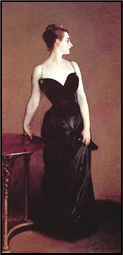 portraiture, a genre in which he excelled, and commissions were not long in coming from America as well as Europe.
portraiture, a genre in which he excelled, and commissions were not long in coming from America as well as Europe.
xxxxxHis first masterpiece was El Jaleo of 1882, the vivacious portrayal of a gypsy dancer, painted during a visit to Spain. Among the best of his works at that time, painted in Paris, were The Lady with the Rose and his sensuous Portrait of Madame X, a controversial work at the time because of the plunging neckline and an off-the-shoulder dress (illustrated). Such was the criticism it received that it played a part in his deciding to leave for London in 1885, a move encouraged by his friend, the American novelist Henry James, then living in England.
xxxxxIn London he was soon at work on a number of portrait commissions, but, under the influence of Monet, he also began to paint out of doors. His first success at the Royal Academy came in 1887 with Carnation, Lily, Lily Rose, a charming portrayal of two young girls lighting paper lanterns in a garden setting (illustrated below). Other, more fashionable portraits followed, including ones of the actress Ellen Terry, the elegant Lady Agnew of Lochnaw, The Wyndham Sisters, and Mrs Hugh Hammersley, a well-known London hostess.
Left to right: Claude Monet painting by the Edge of a Wood, 1885; Bedouins, watercolour c.1905;
and Artist in the Simplon, watercolour c1909.
xxxxxBy 1890 Sargent was painting some 14 portraits a year, and paying many visits to America to meet the demand for portraits and decorative murals and ceiling decorations for a number of public buildings, including Boston Public Library and the Museum of Fine Arts. Amongst his works at this time were three portraits of the Scottish novelist Robert Louis Stevenson, and ones of two U.S. presidents, Theodore Roosevelt and Woodrow Wilson. In his portraits he excelled in capturing the character of the sitter, and for quality as well as quantity he came to be known as “the Van Dyck of our time”.

xxxxxSargent closed his studio in 1907 and then spent much of his time painting landscapes and places of interest in England, across Europe, the Middle East, and parts of the United States. He made some particularly fine studies of Venice, and his watercolour Mountain Stream, probably painted in Italy in about 1910, deserves special mention. During the First World War he visited the frontline in Flanders as an official war artist. Among the paintings he produced was Gassed, (illustrated above), showing a line of stumbling soldiers who had been blinded by mustard gas. It was one of the most poignant images to come out of that dreadful and costly war. He was made a full member of the Royal Academy in 1897 but, anxious to remain an American, refused the offer of a knighthood in 1907.
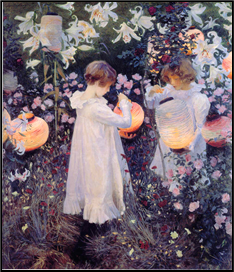
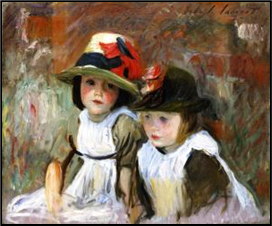 xxxxxDuring his career Sargent produced some 900 oil paintings, more than 2000 water colours, and numerous sketches and quick charcoal portraits. He showed a remarkable flair as a portraitist - particularly when depicting beautiful women and children - and his watercolours, especially his landscapes, were particularly noted for the effects he achieved of both direct and reflected light. Illustrated here are (left) Carnation, Lily, Lily Rose, and (right) The Village Children. Some of his works are not without a touch of impressionism, but basically he was a member of the old school, influenced by the likes of Velazquez, Frans Hals and Gainsborough. He died in 1925. In April of that year he booked a passage to America to take over the last of the decorative panels made for the Boston Public Library, but he died of a heart attack the night before his departure. He thus stayed in England, and was buried at Brookwood Cemetery in Surrey.
xxxxxDuring his career Sargent produced some 900 oil paintings, more than 2000 water colours, and numerous sketches and quick charcoal portraits. He showed a remarkable flair as a portraitist - particularly when depicting beautiful women and children - and his watercolours, especially his landscapes, were particularly noted for the effects he achieved of both direct and reflected light. Illustrated here are (left) Carnation, Lily, Lily Rose, and (right) The Village Children. Some of his works are not without a touch of impressionism, but basically he was a member of the old school, influenced by the likes of Velazquez, Frans Hals and Gainsborough. He died in 1925. In April of that year he booked a passage to America to take over the last of the decorative panels made for the Boston Public Library, but he died of a heart attack the night before his departure. He thus stayed in England, and was buried at Brookwood Cemetery in Surrey.
xxxxxIncidentally, Sargent was a member of the Broadway Group, a colony of artists, mainly American, who often met in the peace and quiet of Broadway, a delightful little village nestling in the Cotswolds in southern England. They congregated in Abbot’s Grange, a 14th century priory, and their noisy antics and high spirits were not always appreciated by the village folk! Among the group was the American novelist Henry James. It was at Broadway that Sargent painted his Carnation, Lily, Lily Rose, the title taken from a popular song of the time.








 of four, the family moved to Le Havre, a busy port in Normandy. Here Monet showed early promise as an artist, and by the age of sixteen he was making quite a good living drawing charcoal caricatures of local people. However,xencouraged by a local marine artist named Eugène Boudin (1824-
of four, the family moved to Le Havre, a busy port in Normandy. Here Monet showed early promise as an artist, and by the age of sixteen he was making quite a good living drawing charcoal caricatures of local people. However,xencouraged by a local marine artist named Eugène Boudin (1824-


 portraiture, a genre in which he excelled, and commissions were not long in coming from America as well as Europe.
portraiture, a genre in which he excelled, and commissions were not long in coming from America as well as Europe.

 xxxxxDuring his career Sargent produced some 900 oil paintings, more than 2000 water colours, and numerous sketches and quick charcoal portraits. He showed a remarkable flair as a portraitist -
xxxxxDuring his career Sargent produced some 900 oil paintings, more than 2000 water colours, and numerous sketches and quick charcoal portraits. He showed a remarkable flair as a portraitist -


